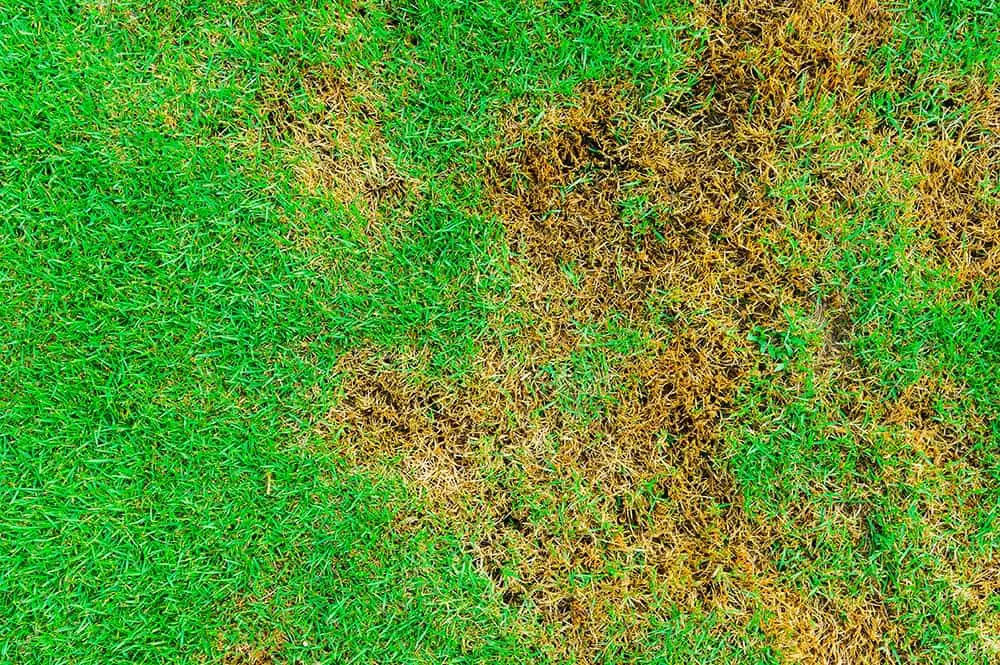You’ve heard rumors, whispers about brown patch fungus and its damaging effects on your grass. You talk about it with your family, friends, and neighbors, but deep down, you carry a dark secret.
You don’t know what brown patch fungus is. Sure it sounds scary, something to be avoided, but you can’t help but wonder, what is brown patch fungus?
It’s too late to ask others what it could be; they might mock you or realize you have been nodding along to conversations without actually saying anything for months now.

But if you don’t know what it is, how can you be sure that your grass isn’t infected? Is your lawn slowly dying in front of you, and you have no idea why?
Do you lie awake at night wondering if your grass is out there, crying for your help, slowly being overtaken by brown patch fungus?
Well, worry no more! We are here to put all your brown patch fungus questions to bed! Today we will look at what brown patch fungus is, how to identify it, and importantly how to save your grass from its fungus fate!
Table of Contents
What is brown patch fungus?
Brown patch fungus, or large patch disease, is a condition caused by a single species of fungus, Rhizoctonia. You are most likely to see the fungus in mid to late summer or during hot and humid weather conditions.
These conditions are prime times for the fungus to spread and thrive in your garden.
Any prolonged wetness gives the fungus the perfect breeding ground to spread and damage your grass.
Whether it’s from the dew, rain, nighttime, evening watering, or poor drainage, wet grass at temperatures over 80F in the day and 65F at night are the perfect conditions for brown patch fungus to spread.
It’s not just the weather; grass that has been overstimulated by nitrogen fertilizer can be susceptible to brown patch fungus. It is especially prone to the fungs if the fertilizer has been used before or during hot and humid weather.
When it comes to fertilizing your grass, avoid overdoing it, especially if hot weather is approaching!
The fungus will enter and infect the leaves of your grass, causing them to rot and changing the color from luscious green to yellow-brown color. The fungus can affect all cool-season grasses but is very harmful to ryegrass and tall fescue.
It also affects a range of warm-season grasses such as St. Augustine grass, Bermuda, and zoysiagrass. The trouble with brown patch fungus is that once you have spotted it, the damage is done, and the pesky fungus is thriving on your lawn!
Thankfully there are some ways to eradicate the fungus, but you need to go deeper than the grass; getting into the soil is your best way to evict the fungus (more on this later!).
Now that we have covered what brown patch fungus is, let’s move on to identifying it and, importantly, finding out if it can be cured!
What does brown patch fungus look like?
You would assume that brown patch fungus is simply a brown patch on your lawn, yes? Well, the actual answer is slightly more complicated than that. Brown patch fungus starts as a circle or oblong-shaped pattern of light-yellow on your grass.
As time goes on, the patches will change from orange to tan color, often when people notice the fungus. Typically, brown patch fungus will look like circular patches on your grass.
They can be irregular shapes and brownish-yellow in color. These shapes will spread outwards and sometimes have patches of green grass within them too.
While there are some discrepancies in the shape and color, you should be able to identify the fungus easily now!
Can brown patch be spread by mowers?
No, brown patch fungus is generally not spread by mowers. The fungus needs its hot, humid, and wet conditions to thrive in the grass.
If the mower was used on the grass with brown patch fungus and then another grass with a similar environment, there is a chance that the fungus could be spread.
However, the chance of it spreading is very small. If the mowers are used on grass with a different environment, then no, the brown patch fungus will not be spread by the mower, and there will be no need to disinfect the mower in between uses.
Can brown patch be cured?
No, the brown patch cannot be cured as such. Instead, we can control and prevent the fungus from returning your grass to its former glory! There is a range of methods you can try, either on their own or with one another.
A fungicide can help to get rid of brown patch fungus. These are best for high-value ryegrass and bentgrass turf blends, while most lawns will revolver without chemical treatments.
Spray your fungicide as soon as symptoms appear in hot and humid environments (we will cover the best fungicides shortly).
To prevent brown patch fungus and stop it from reappearing once treated, reseed your lawn with resistant grass cultivars. These feature a moderate resistance to the Rhizoctonia fungus found in brown patch fungus.
If your grass is prone to fungus, this can be an excellent solution!
Avoiding over-fertilizing or fertilizing your grass during hot and humid conditions is the best way to prevent brown patch fungus from infecting your grass.
Improving the air circulation and watering the grass only when needed will also help prevent the fungus from rearing its ugly head again!
What is the best fungicide for brown patch?
Azoxystrobin or pyraclostrobin are the best fungicides to use to treat brown patch fungus. These fungicides will control the fungus for 28 days, providing the longest time of protection than other fungicides.
Other fungicides will typically control brown patch fungus for 14 days. When purchasing your fungicide, look out for azoxystrobin or pyraclostrobin listed on the bottle.
When using the fungicide, follow the instructions on the label, but remember, it is best to treat the fungus as soon as you notice it!

